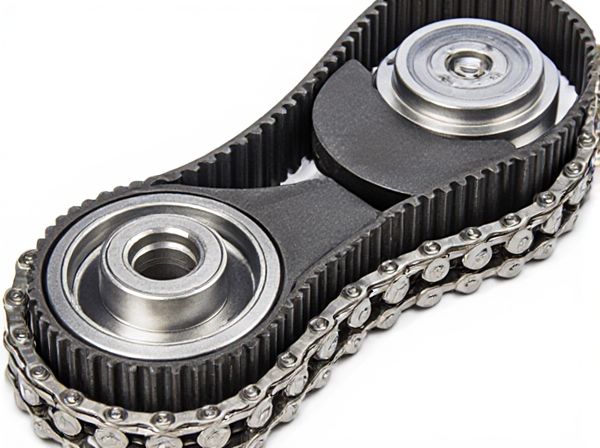
Photo illustration: Belt-drive System vs Chain-drive System
Belt-drive systems offer smooth, quiet operation and require less maintenance compared to chain-drive systems, which are known for their strength and ability to handle higher torque loads. Your choice between these systems should consider factors like durability, efficiency, and noise levels for the specific application. Belt drives excel in reducing vibration and slippage, while chain drives provide more reliable power transmission in harsh environments.
Table of Comparison
| Feature | Belt-drive System | Chain-drive System |
|---|---|---|
| Material | Reinforced rubber | Metal alloy chain |
| Durability | 50,000-100,000 miles | 100,000+ miles |
| Maintenance | Requires periodic replacement | Minimal maintenance needed |
| Noise Level | Quiet operation | Noisier during running |
| Cost | Lower initial cost | Higher upfront cost |
| Failure Risk | Higher risk leads to engine damage | Lower failure risk, more reliable |
| Common Usage | Most modern passenger cars | Heavy-duty and high-performance engines |
Introduction to Drive Systems
Belt-drive systems use flexible belts made from rubber or synthetic materials to transfer power between rotating shafts, offering quieter operation and reduced maintenance compared to chain-drive systems. Chain-drive systems employ metal chains that engage sprockets to deliver positive, slip-free power transmission, ideal for high-torque applications and precise timing requirements. Both drive systems are integral to mechanical power transfer in automotive, industrial, and machinery contexts, with selection criteria based on factors such as load capacity, efficiency, noise levels, and environmental conditions.
Overview of Belt-Drive Systems
Belt-drive systems use flexible belts made of rubber, polyurethane, or reinforced composites to transmit power between pulleys, providing smooth and quiet operation with low maintenance requirements. These systems excel in applications requiring vibration dampening and reduced noise, making them ideal for industrial machinery, automotive engines, and HVAC systems. Belt drives offer high efficiency, less lubrication need, and resistance to corrosion compared to traditional chain-drive systems, but generally deliver lower torque capacity and are more sensitive to misalignment.
Overview of Chain-Drive Systems
Chain-drive systems use a series of metal links interconnected to transfer mechanical power between sprockets, offering high torque transmission and durability. These systems require regular lubrication and maintenance to prevent wear and elongation, impacting performance over time. Commonly found in motorcycles, bicycles, and industrial machines, chain drives provide efficient power transfer with minimal slip compared to belt-drive systems.
Key Components and Mechanisms
Belt-drive systems utilize flexible belts made from rubber or synthetic materials that loop around pulleys, providing smooth and quiet power transmission with minimal maintenance. Chain-drive systems consist of interlinked metal chains engaging with sprockets, offering high strength and durability for heavy loads and precise mechanical timing. Key mechanisms in belt drives rely on friction between belt and pulley surfaces, while chain drives depend on meshing teeth for positive engagement and efficient torque transfer.
Performance Comparison
Belt-drive systems offer quieter operation and require less maintenance due to their smooth, low-friction transmission, resulting in higher efficiency at moderate power levels. Chain-drive systems excel in durability and torque transfer, providing superior performance under heavy loads and high-stress conditions, often favored in motorcycles and industrial machinery. The choice between belt-drive and chain-drive hinges on the need for efficiency and noise reduction versus strength and load capacity in specific applications.
Efficiency and Power Transmission
Belt-drive systems offer smoother and quieter operation with lower maintenance but generally exhibit slightly lower power transmission efficiency compared to chain-drive systems. Chain-drive systems provide higher torque capacity and more efficient power transfer, making them ideal for heavy-duty applications despite increased noise and wear. Efficiency in belt drives typically ranges from 90-98%, while chain drives can achieve efficiencies of 98-99% under optimal conditions.
Maintenance Requirements
Belt-drive systems require less frequent maintenance due to their enclosed design, which protects belts from dirt and debris, reducing wear and elongation. Chain-drive systems demand regular lubrication and tension adjustments to prevent rust, wear, and potential chain slippage. Overall, belt drives offer lower maintenance costs and longer service intervals compared to chain drives, making them suitable for applications prioritizing reliability and reduced downtime.
Durability and Lifespan
Belt-drive systems offer superior durability and longer lifespan compared to chain-drive systems due to their resistance to rust, corrosion, and reduced need for lubrication. Chain-drive systems, while robust, are prone to wear and stretch over time, requiring regular maintenance and eventual replacement. High-quality belt drives can last up to 50,000 miles or more with minimal upkeep, whereas chain drives typically need replacement around 20,000 to 30,000 miles depending on use and maintenance.
Cost Considerations
Belt-drive systems generally have lower initial costs and reduced maintenance expenses due to longer lifespan and quieter operation compared to chain-drive systems. Chain-drive systems, while often cheaper upfront, require frequent lubrication, tension adjustments, and replacement of worn parts, increasing long-term maintenance costs. Factoring in durability and maintenance frequency, belt drives typically offer better cost efficiency over the product lifecycle.
Application Suitability and Recommendations
Belt-drive systems excel in applications requiring low maintenance, smooth operation, and noise reduction, making them ideal for HVAC systems, woodworking machinery, and light-duty industrial equipment. Chain-drive systems are better suited for high-torque, heavy-load applications such as motorcycles, agricultural machinery, and conveyor systems where durability and precise power transmission are critical. For environments demanding efficiency and quiet performance, belt drives are recommended, whereas chain drives are preferred in rugged, high-stress settings.
 caratoz.com
caratoz.com